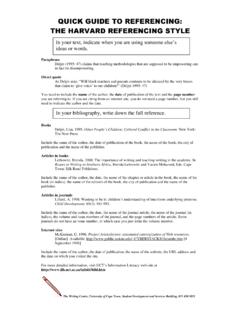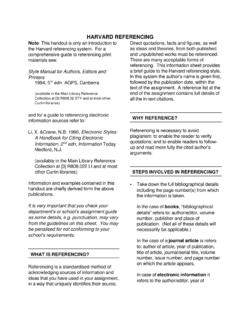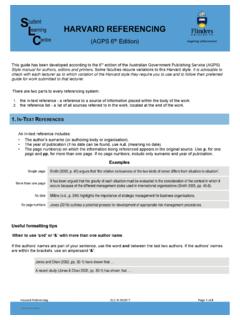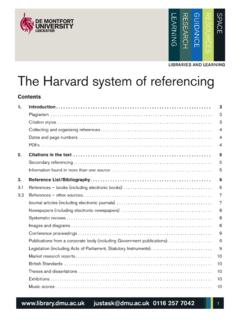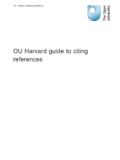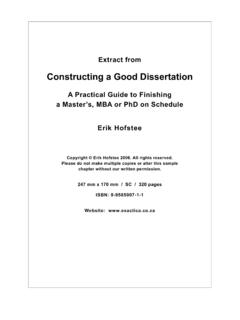Transcription of Harvard referencing 2010 - Biosocial Society
1 University Library guide to the Harvard Style of referencing September 2010. Anglia Ruskin University ++`. guide to the Harvard Style of referencing Second Edition Revised September 2010. 1. Anglia Ruskin University 1. GENERAL INTRODUCTION .. 4. Explanation of citation and referencing ..4. Plagiarism ..4. referencing 2. CITING REFERENCES INTEXT USING THE Harvard 6. Author's name cited in the Author's name not cited directly in the More than one author cited in the More than one author not cited directly in the text ..7. Two, three or four authors for the same work ..7. More than four authors for a work ..7. Several works by one author in different years ..8. Several works by one author in the same year ..8. Chapter authors in edited works.
2 8. Corporate authors ..9. No author ..9. No date ..10. Page Quoting portions of published Secondary sources (second-hand references) ..11. Tables and Websites ..13. 3. COMPILING THE REFERENCE LIST AND 14. General guidelines, layout and punctuation ..14. Books ..14. Books with one author ..14. Books with two, three or four Books with more than four authors ..15. Books which are edited ..16. Chapters of edited books ..16. Multiple works by the same Books which have been translated ..17. Journal articles and Journal Journal articles available from a database ..19. Magazine or journal articles available on the internet ..20. Journal abstract from a Newspaper articles ..20. Online newspaper 4. OTHER TYPES OF DOCUMENT .. 22. Acts of Parliament.
3 22. 2. Anglia Ruskin University Statutory Official publications such as Command Papers ..22. Law reports ..23. Annual report ..23. Archive material ..24. British Standard and International Patent ..24. Conference report ..25. Conference paper ..25. Dissertation ..25. DVD, video or film ..26. Broadcasts ..26. EU documents ..26. Course Map ..28. Quotations from written Pictures, images and Press release ..30. 5. ELECTRONIC SOURCES .. 32. Websites ..32. Publications available from Electronic Email correspondence/discussion Blogs ..35. Mailing list ..36. Podcast or archived tv programme ..36. YouTube 6. UNPUBLISHED 37. Unpublished Informal or in-house publications ..37. Personal 7. REFERENCES WITH MISSING DETAILS .. 38. 8. NOTES FROM COMPILERS AND CHANGES INTRODUCED TO SECOND.
4 39. 3. Anglia Ruskin University 1. GENERAL INTRODUCTION. Explanation of citation and referencing During the course of writing an essay, report or other assignment it is usual to support arguments by reference to other published work. These references may be from work presented in journal or newspaper articles, government reports, books or specific chapters of books, research dissertations or theses, material over the internet etc. Citation is the practice of referring to the work of other authors in the text of your own piece of work. Such works are cited to show evidence both of the background reading that has been done and to support the content and conclusions. Each citation requires a reference at the end of the work; this gives the full details of the source item and should enable it to be traced.
5 Referring accurately to such source materials is part of sound academic practice and a skill that should be mastered. Other reasons for accurate citation and referencing are: To give credit to the concepts and ideas of other authors To provide the reader (often the marker/examiner of the assignment) with evidence of the breadth and depth of your reading To enable those who read your work to locate the cited references easily Remember to note the details of all the documents you read The following pages give detailed guidance for various types of documents as there are major differences between books, journal articles and websites. These are based on consultation with colleagues at Anglia Ruskin University, with examples, in red, for illustrative purposes.
6 Plagiarism Plagiarism is passing off the work of others as your own. This constitutes academic theft and is a serious matter which is penalised in assignment marking. The following extract is from the Anglia Ruskin University Academic Regulations (2010) For full details see: Anglia Ruskin University. 2010. Anglia Ruskin University Academic Regulations. [online]. 3rd edition. 2010. Available at: < >. 4. Anglia Ruskin University Plagiarism and collusion are common forms of assessment offence. They are defined as follows: Plagiarism . Plagiarism is the submission of an item of assessment containing elements of work produced by another person(s) in such a way that it could be assumed to be the student's own work. Examples of plagiarism are: the verbatim copying of another person's work without acknowledgement the close paraphrasing of another person's work by simply changing a few words or altering the order of presentation without acknowledgement the unacknowledged quotation of phrases from another person's work and/or the presentation of another person's idea(s) as one's own.
7 Copying or close paraphrasing with occasional acknowledgement of the source may also be deemed to be plagiarism if the absence of quotation marks implies that the phraseology is the student's own. Plagiarised work may belong to another student or be from a published source such as a book, report, journal or material available on the internet.. referencing systems There are a number of systems for the citation of references. Anglia Ruskin University expects students to use the alphabetical/name-date system, in a particular style, known as the Harvard style. In this, for a book, the author's surname and year of publication are cited in the text, (Bond, 2004) and a reference list (of these citations) is included at the end of the assignment, in alphabetical order by authorship with date.
8 This reference list will also include the full details of the document. A bibliography lists relevant items that you have used in the preparation of the assignment but not necessarily cited in your text. If you include a bibliography in your work, this should also be in the Harvard style and will demonstrate that you have read widely. As Faculty regulations may differ in the use of bibliographies and reference lists, students are advised to check with their Faculty. 5. Anglia Ruskin University 2. CITING REFERENCES INTEXT using the Harvard System Any intext reference should include the authorship and the year of the work. Depending on the nature of the sentence/paragraph that is being written, references to sources may be cited in the text in the following manner: Author's name cited in the text When making reference to an author's work in your text, their name is followed by the year of publication of their work: In general, when writing for a professional publication, it is good practice to make reference to other relevant published work.
9 This view has been supported in the work of Cormack (1994). Where you are mentioning a particular part of the work, and making direct reference to this, a page reference should be included: Cormack (1994, ) states that 'when writing for a professional readership, writers invariably make reference to already published works'. Author's name not cited directly in the text If you make reference to a work or piece of research without mentioning the author in the text then both the author's name and publication year are placed at the relevant point in the sentence or at the end of the sentence in brackets: Making reference to published work appears to be characteristic of writing for a professional audience (Cormack, 1994). More than one author cited in the text Where reference is made to more than one author in a sentence, and they are referred to directly, they are both cited: Jones (1946) and Smith (1948) have both shown.
10 6. Anglia Ruskin University More than one author not cited directly in the text List these at the relevant point in the sentence or at the end of the sentence, putting the author's name, followed by the date of publication and separated by a semi-colon and within brackets. Where several publications from a number of authors are referred to, then the references should be cited in chronological order ( earliest first): Further research in the late forties (Jones, 1946; Smith, 1948) led to major developments . (Collins, 1998; Brown, 2001; Davies, 2008). Two, three or four authors for the same work When there are two authors for a work they should both be noted in the text: White and Brown (2004) in their recent research paper found . with regard to PREP and the role of libraries, Crane and Urquhart (1994).
